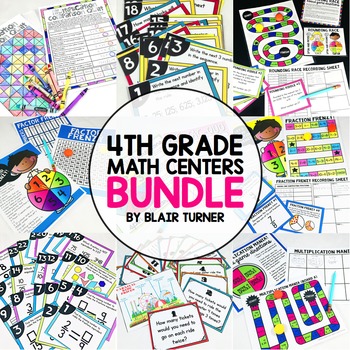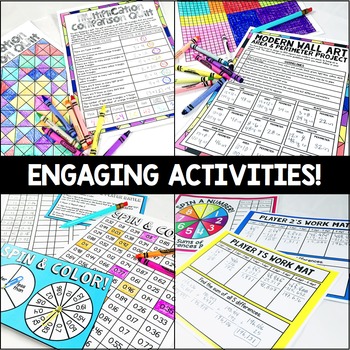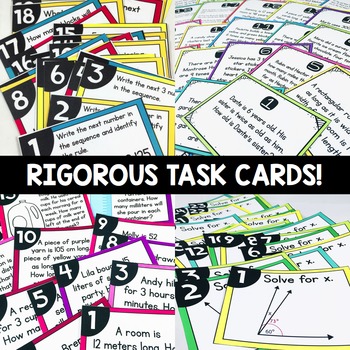4th Grade Math Centers {ALL STANDARDS BUNDLE}
- Zip
What educators are saying
Products in this Bundle (28)
showing 1-5 of 28 products
Description
Make math fun and engaging for your 4th grade students!
This BUNDLE includes one center for each of the 28 Common Core math standards for 4th grade.
•Use throughout the year to teach, review, and sharpen math skills
•Reinforce key concepts at any time of the year
•Use as an engaging & valuable test prep tool
The centers consist of task cards, games, and activities, depending on the standard. Each center is designed to be a high-rigor review of the essential concepts for 4th grade, in an accessible format that students can complete independently.
••••••••••••••••••••••••••••••••••••••••••••••••••••••••••••••••••••••••••••••••••••••
CENTERS INCLUDED:
Geometry Center Bundle: 4th Grade Math
Geometry Task Cards (4.G.1)
Geometry Card Game (4.G.2)
Symmetry Bingo (4.G.3)
Numbers and Operations in Base Ten Center Bundle: 4th Grade Math
Place Value Game (4.NBT.1)
Number Duel: Comparing Numbers Game (4.NBT.2)
Rounding Race Board Game (4.NBT.3)
Sums of Differences Battle (4.NBT.4)
Multi-Digit Multiplication Mania Board Game (4.NBT.5)
Long Division Tic-Tac-QUO Game (4.NBT.6)
Operations and Algebraic Thinking Center Bundle: 4th Grade Math
Multiplication as Comparison - Design a Quilt! (4.OA.1)
Multiplicative Comparison Task Cards (4.OA.2)
Multi-Step Word Problem Task Cards (4.OA.3)
Factor Pair Frenzy Game (4.OA.4)
Patterns Task Cards (4.OA.5)
Numbers and Operations FRACTIONS Center Bundle: 4th Grade Math
Equivalent Fractions Task Cards (4.NF.1)
Comparing Fractions Task Cards (4.NF.2)
Adding and Subtracting Fractions Board Game (4.NF.3)
Multiplying Fractions by Whole Numbers Task Cards (4.NF.4)
Fraction Puzzles - Adding Tenths and Hundredths (4.NF.5)
Decimal Notation Task Cards (4.NF.6)
Comparing Decimals Game (4.NF.7)
Measurement and Data Center Bundle: 4th Grade Math
Measurement Conversions Board Game (4.MD.1)
Measurement Word Problems Task Cards (4.MD.2)
Area and Perimeter of Rectangles Real World Art Project (4.MD.3)
Line Plots Mini-Project (4.MD.4)
Angle Bingo (4.MD.5)
Measuring Angles/Polygon Exploration (4.MD.6)
Additive Angle Measures Task Cards (4.MD.7)
••••••••••••••••••••••••••••••••••••••••••••••••••••••••••••••••••••••••••••••••••••••
Although these centers are designed to meet the Common Core standards, the skills reviewed by them are important for all students, regardless of which standards you follow. There are NO references to the Common Core or the standard number on student pages, so these centers are a great addition to any classroom!
••••••••••••••••••••••••••••••••••••••••••••••••••••••••••••••••••••••••••••••••••••••
THIS PRODUCT IS ALSO AVAILABLE FOR 3RD GRADE:
3rd Grade Math Center Bundle: ALL Common Core Standards
••••••••••••••••••••••••••••••••••••••••••••••••••••••••••••••••••••••••••••••••••••••
This product works well with the following items:
Math Interactive Notebook: 4th Grade Common Core {A best-selling resource!}
The Ultimate CCSS Classroom Kit GRADE 4
••••••••••••••••••••••••••••••••••••••••••••••••••••••••••••••••••••••••••••••••••••••
© Blair Turner, One Lesson at a Time, Inc.
Materials are licensed for personal use in one classroom only. For use in multiple classrooms, please help support my work by purchasing additional licenses. Thank you!





